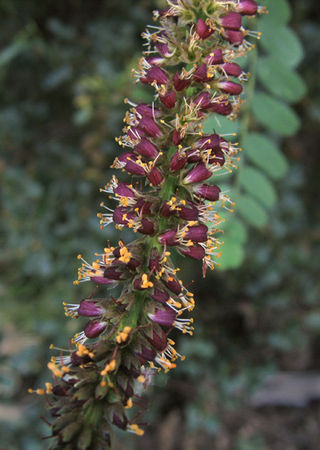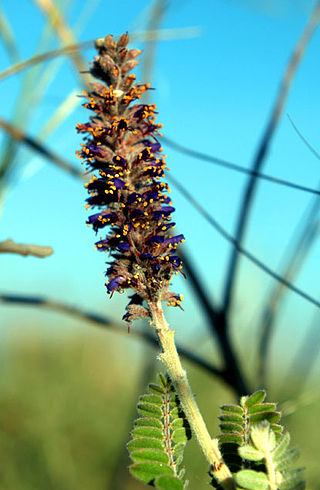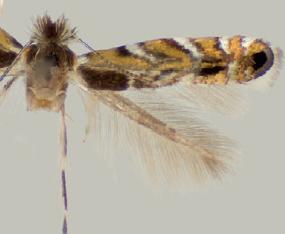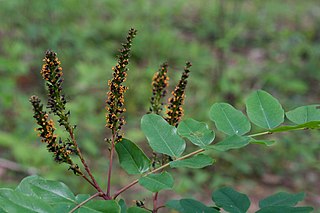
The longhorn beetles (Cerambycidae), also known as long-horned or longicorns, are a large family of beetles, with over 35,000 species described.

Amorpha is a genus of plants in the pea family, Fabaceae. All the species are native to North America, from southern Canada, most of the United States (US), and northern Mexico. They are commonly known as false indigo. The name Amorpha means "deformed" or "without form" in Greek and was given because flowers of this genus only have one petal, unlike the usual "pea-shaped" flowers of the Faboideae subfamily. Amorpha is missing the wing and keel petals.
The common name indigo bush can refer to plants in any of several genera in the legume family, including:

Amorpha juglandis, the walnut sphinx, is the only species in the monotypic moth genus Amorpha, which is in the family Sphingidae, erected by Jacob Hübner in 1809. The species was first described by James Edward Smith in 1797.

Amorpha californica is a species of flowering plant in the legume family known by the common name California false indigo.
The enzyme amorpha-4,11-diene synthase (ADS) catalyzes the chemical reaction

Amorpha fruticosa is a species of flowering plant in the legume family Fabaceae, known by several common names, including desert false indigo, false indigo-bush, and bastard indigobush. It is native to North America.

Zerene cesonia, the southern dogface, is a North and South American butterfly in the family Pieridae, subfamily Coliadinae.

Leptotes cassius, the Cassius blue or tropical striped blue, is a butterfly of the family Lycaenidae. It is found in North America in Florida including the Keys, Texas south through the Caribbean, Mexico, and Central America to South America. Strays have been found in New Mexico, Kansas, Missouri, South Carolina, North Carolina and Virginia.

Amorpha canescens, known as leadplant, downy indigo bush, prairie shoestring, or buffalo bellows, is a small, perennial semi-shrub in the pea family (Fabaceae), native to North America. It has very small purple flowers with yellow stamens which are grouped in racemes. Depending on location, the flowers bloom from late June through mid-September. The compound leaves of this plant appear leaden due to their dense hairiness. The roots can grow up to 5 m (16 ft) deep and can spread up to 1 metre radially. This plant can be found growing in well-drained soils of prairies, bluffs, and open woodlands.

Amorpha nana is a 1–3-foot (30–91 cm) tall perennial shrub in the Pea family (Fabaceae) which is native to North America. It has vibrant green pinnate leaves and clusters of purple flowers. The fruits are small pods. Dwarf false indigo grows in dry prairies and rocky hillsides. Amorpha nana likes rocky and sandy soil.

Macrosaccus uhlerella is a moth of the family Gracillariidae. It is known from Illinois, Missouri, New York, Colorado and Texas in the United States.

Rotenoids are naturally occurring substances containing a cis-fused tetrahydrochromeno[3,4-b]chromene nucleus. Many have insecticidal and piscicidal activity, such as the prototypical member of the family, rotenone. Rotenoids are related to the isoflavones.

Amorpha ouachitensis is an uncommon North American species of flowering plant in the legume family known by the common names Ouachita leadplant, Ouachita Mountain leadplant, Ouachita false indigo, and Ouachita indigobush. It is native to Oklahoma and Arkansas in the United States.
Amorpha-4,11-diene 12-monooxygenase (EC 1.14.13.158, CYP71AV1) is an enzyme with systematic name amorpha-4,11-diene,NADPH:oxygen oxidoreductase (12-hydroxylating). This enzyme catalyses the following chemical reaction
Mesorhizobium amorphae is a species of root nodule bacteria first isolated from Amorpha fruticosa species in China. It is purported to be native to American soil. Its genome has been sequenced. Its type strain is ACCC 19665.

Amorpha nitens, the shining false indigo, is a species of flowering plant in the pea family. It is native to the southern United States, in Arkansas, Tennessee, Oklahoma, Louisiana, Illinois, Alabama, Georgia, Kentucky and South Carolina.
Amorpha apiculata is a species of papilionate leguminous shrub known commonly as the Baja California false-indigo. It is a very rare narrow endemic only found in the Sierra de San Pedro Martir and its western foothills. It is characterized by a white vexillum, a smooth, hairless fruit and spine-like glands. It is closely related to Amorpha californica.












